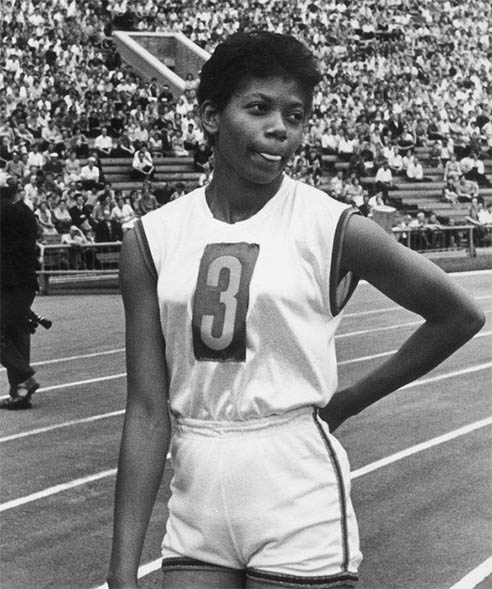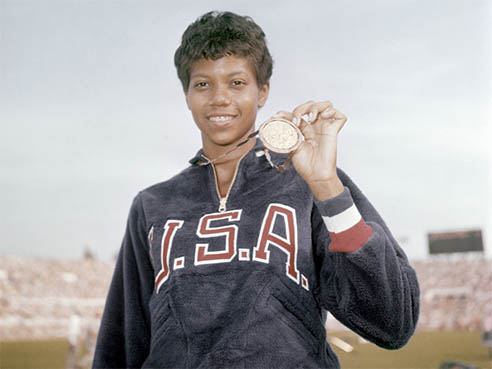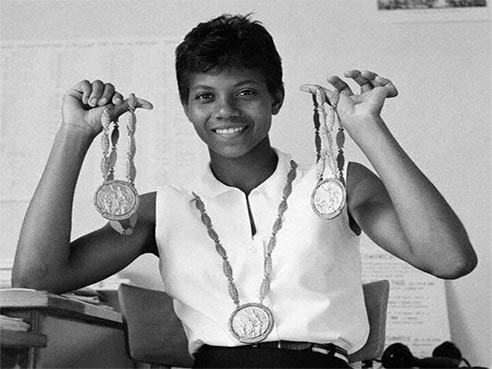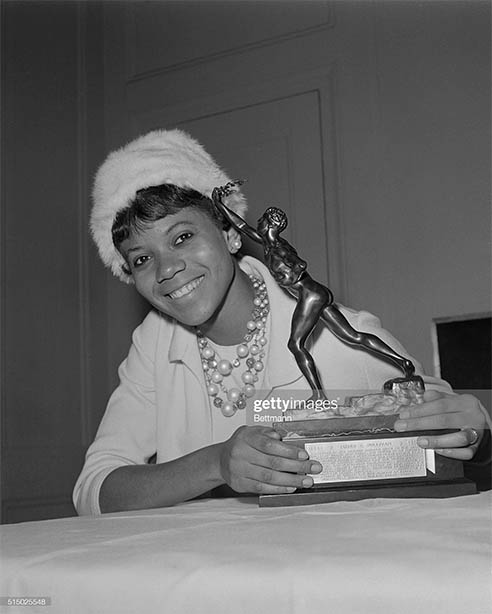Black History Month Spotlight: Wilma Rudolph
02/17/2022
Black History Month is an annual celebration of the achievements by Black Americans and a time for recognizing their impact in U.S. history. For the third week in February 2022, we commemorate the “Queen of the Olympics,” AAU Alumna, and AAU Sullivan Award Recipient, Wilma Rudolph.
By: Troy MacNeill
ORLANDO, Fla. (2022) – Wilma Rudolph, born on June 23, 1940, overcame disabilities, stereotypes, and pressures from a cultural Cold War to become the fastest woman in the world. Rudolph showed the world, that no matter how many obstacles stand in your way, everyone can be special in their own way.
Rudolph has been known by many nicknames over the years. She was referred to as “the Tennessee Tornado,” and “the Chattanooga Choo-Choo” by friends back home. The Italian press dubbed her “the Black Pearl,” the French press called her “the Black Gazelle.” In 1960 during the Summer Olympics, the world would come to know her as “the Queen of the Olympics.” However, Rudolph was not always seen as the track star who could speed past any racer. She started with a single step to prove she was special.
Rudolph was born prematurely and only weighed 4.5 pounds at birth. She was the 20th of 22 children born into a modest family growing up in Clarksville, Tennessee. At 4 years old, Rudolph became sick with both pneumonia and scarlet fever. At 5 years old, due to being bedridden, she contracted polio causing her to lose the strength and use of her left leg. There was little medical care available for Black Americans in Clarksville in the 40s, so Rudolph’s parents would drive her 50 miles to Nashville for treatments. Rudolph for the first 11 years of her life, was confined to a leg brace and orthopedic shoe.
It was this determination that would help her become an Olympic track and field champion and all-time great less than two decades later. Continued support from her mother and an internal drive pushed Rudolph forward until she was proving everyone wrong.
For two years, Rudolph and her mother would make a weekly bus ride into the segregated south to find a doctor who would help. She began to receive therapy to strengthen her weakened left leg, but doctors told Rudolph that she would never walk properly again. “My mother told me I would,” Rudolph wrote. “I believed my mother.”
Through therapy, exercises, and massages at home, Rudolph began to regain strength in her leg. She then began to try what doctors told her would never happen. While she knew that the brace was important to her recovery, she also admitted that she would often try to take it off.
“I would take off my braces, then station my brothers and sisters all through the house and they would tell me if my parents were coming and then I’d hurry and put the braces back on,” she wrote in the Chicago Tribune.
She would soon take her skills to the basketball court and the track at her high school. After joining the girls’ track team, Rudolph knew she had found her calling. She was beating all of the girls on the track team, and challenging all of the girls at the school. The more people she beat, the more attention she received. Before long, while still in high school, she was training with college students from Tennessee State University. Before she even started attending Tennessee State University, at 16 years old, Rudolph qualified for the 1956 Summer Olympics in Melbourne, Australia as the youngest member of the U.S. Track team and showed the world what she could accomplish.
Rudolph ran the third leg of the 4 x 100 meter relay race for Team USA. Rudolph and her teammates would match a world-record time but have to settle for the Bronze medal in this race. On an international stage, Rudolph showed her potential and was welcomed back to school as a champion. However, after returning, she was not satisfied and vowed to get better in order to take home gold in the next Olympics.
“I took it {Bronze medal} and I started shining it up — I discovered that bronze doesn’t shine. So, I decided I’m going to try this one more time. I’m going to go for the gold.”
While she was becoming a force in the track game, in 1960, back on a global stage at the Summer Olympics in Rome, Italy, Rudolph would be crowned the Queen.
The title of “fastest woman in the world” was given to Rudolph after she broke record after record in the 1960 Olympics. Rudolph ran an 11.0 second 100-meter dash to break the world record and win gold. She ran a 23.2 second 200-meter dash to break the world record and win gold. Additionally, she ran the last leg of a record breaking 44.4 second 4 x 100-meter relay race to help Team USA capture gold. Rudolph became the “Queen of the Olympics” after becoming the first American woman to win 3 gold medals in track and field at a single Olympic Games. Rudolph instantly became a household name and an international superstar.
Back home in Clarksville, Tennessee in the segregated 1960s, Rudolph chose to stay true to her values and continue to change the stereotypes surrounding her. Governor of Tennessee, Buford Ellington, wanted to hold a parade to welcome the star home, but Rudolph refused to attend a segregated event. Instead, her parade and banquet became the first integrated events in Clarksville. In 1963, after becoming a well-known name, Rudolph continued to fight for integration. She joined 300 activists seeking service at a segregated restaurant in Clarksville, hoping for change. She also stood beside Muhammad Ali, her fellow Team USA Olympian, during his fight for peace.
After her competition days were over, Rudolph started the Wilma Rudolph Foundation to promote amatuer athletics and continue to grow sports for young athletes. In 1996, the Women's Sports Foundation presented the first Wilma Rudolph Courage Award. The award is presented annually to a female athlete who exhibits courage in her sport as well and an ability to overcome adversity.
Today Rudolph is remembered as not only one of the fastest women to ever live, but also a barrier-breaking athlete. She made women’s track popular, she showed that black athletes and female athletes could be seen as cultural icons. Rudolph should also forever be seen as a source of great inspiration for all athletes. After being told no and that things were not possible, she continued believing in herself. She continued to show why she was special. She went from not being able to walk, to going the distance and speeding past her doubters.
“Nobody goes undefeated all the time. If you can pick up after a crushing defeat, and go on to win again, you are going to be a champion someday.”
ORLANDO, Fla. (2022) – Wilma Rudolph, born on June 23, 1940, overcame disabilities, stereotypes, and pressures from a cultural Cold War to become the fastest woman in the world. Rudolph showed the world, that no matter how many obstacles stand in your way, everyone can be special in their own way.
Rudolph has been known by many nicknames over the years. She was referred to as “the Tennessee Tornado,” and “the Chattanooga Choo-Choo” by friends back home. The Italian press dubbed her “the Black Pearl,” the French press called her “the Black Gazelle.” In 1960 during the Summer Olympics, the world would come to know her as “the Queen of the Olympics.” However, Rudolph was not always seen as the track star who could speed past any racer. She started with a single step to prove she was special.
Rudolph was born prematurely and only weighed 4.5 pounds at birth. She was the 20th of 22 children born into a modest family growing up in Clarksville, Tennessee. At 4 years old, Rudolph became sick with both pneumonia and scarlet fever. At 5 years old, due to being bedridden, she contracted polio causing her to lose the strength and use of her left leg. There was little medical care available for Black Americans in Clarksville in the 40s, so Rudolph’s parents would drive her 50 miles to Nashville for treatments. Rudolph for the first 11 years of her life, was confined to a leg brace and orthopedic shoe.

It was this determination that would help her become an Olympic track and field champion and all-time great less than two decades later. Continued support from her mother and an internal drive pushed Rudolph forward until she was proving everyone wrong.
For two years, Rudolph and her mother would make a weekly bus ride into the segregated south to find a doctor who would help. She began to receive therapy to strengthen her weakened left leg, but doctors told Rudolph that she would never walk properly again. “My mother told me I would,” Rudolph wrote. “I believed my mother.”
Through therapy, exercises, and massages at home, Rudolph began to regain strength in her leg. She then began to try what doctors told her would never happen. While she knew that the brace was important to her recovery, she also admitted that she would often try to take it off.
“I would take off my braces, then station my brothers and sisters all through the house and they would tell me if my parents were coming and then I’d hurry and put the braces back on,” she wrote in the Chicago Tribune.

She would soon take her skills to the basketball court and the track at her high school. After joining the girls’ track team, Rudolph knew she had found her calling. She was beating all of the girls on the track team, and challenging all of the girls at the school. The more people she beat, the more attention she received. Before long, while still in high school, she was training with college students from Tennessee State University. Before she even started attending Tennessee State University, at 16 years old, Rudolph qualified for the 1956 Summer Olympics in Melbourne, Australia as the youngest member of the U.S. Track team and showed the world what she could accomplish.
Rudolph ran the third leg of the 4 x 100 meter relay race for Team USA. Rudolph and her teammates would match a world-record time but have to settle for the Bronze medal in this race. On an international stage, Rudolph showed her potential and was welcomed back to school as a champion. However, after returning, she was not satisfied and vowed to get better in order to take home gold in the next Olympics.
“I took it {Bronze medal} and I started shining it up — I discovered that bronze doesn’t shine. So, I decided I’m going to try this one more time. I’m going to go for the gold.”
 " />
" />
While she was becoming a force in the track game, in 1960, back on a global stage at the Summer Olympics in Rome, Italy, Rudolph would be crowned the Queen.
The title of “fastest woman in the world” was given to Rudolph after she broke record after record in the 1960 Olympics. Rudolph ran an 11.0 second 100-meter dash to break the world record and win gold. She ran a 23.2 second 200-meter dash to break the world record and win gold. Additionally, she ran the last leg of a record breaking 44.4 second 4 x 100-meter relay race to help Team USA capture gold. Rudolph became the “Queen of the Olympics” after becoming the first American woman to win 3 gold medals in track and field at a single Olympic Games. Rudolph instantly became a household name and an international superstar.

Back home in Clarksville, Tennessee in the segregated 1960s, Rudolph chose to stay true to her values and continue to change the stereotypes surrounding her. Governor of Tennessee, Buford Ellington, wanted to hold a parade to welcome the star home, but Rudolph refused to attend a segregated event. Instead, her parade and banquet became the first integrated events in Clarksville. In 1963, after becoming a well-known name, Rudolph continued to fight for integration. She joined 300 activists seeking service at a segregated restaurant in Clarksville, hoping for change. She also stood beside Muhammad Ali, her fellow Team USA Olympian, during his fight for peace.

After her competition days were over, Rudolph started the Wilma Rudolph Foundation to promote amatuer athletics and continue to grow sports for young athletes. In 1996, the Women's Sports Foundation presented the first Wilma Rudolph Courage Award. The award is presented annually to a female athlete who exhibits courage in her sport as well and an ability to overcome adversity.
Today Rudolph is remembered as not only one of the fastest women to ever live, but also a barrier-breaking athlete. She made women’s track popular, she showed that black athletes and female athletes could be seen as cultural icons. Rudolph should also forever be seen as a source of great inspiration for all athletes. After being told no and that things were not possible, she continued believing in herself. She continued to show why she was special. She went from not being able to walk, to going the distance and speeding past her doubters.
“Nobody goes undefeated all the time. If you can pick up after a crushing defeat, and go on to win again, you are going to be a champion someday.”

 Email
Email Print
Print









